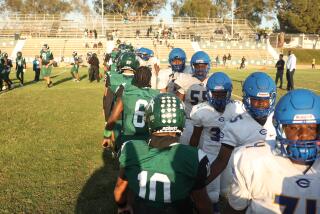Closed doors on Crenshaw
IKNEW IT was coming.
Crenshaw Motors Ford, the last surviving car dealership on the boulevard, closed up shop two weeks ago. I was chagrined by the news, but not surprised. Crenshaw Motors had been on a precipice for the last few years, what with Ford bleeding money and trying to recoup by slashing jobs and closing plants. When the Beverly Hills dealership closed late last year, I figured Crenshaw Motors’ days were numbered. Every time I drove by the lot at the corner of 53rd, I breathed a sigh of relief to see it still open, sleek new cars and trucks arrayed beneath the towering blue-and-white neon sign that looked almost hand-lettered, a remnant of the Art Deco age in which it debuted. And I felt fresh anxiety that this glimpse of the Crenshaw corridor’s most visible and vulnerable business would be my last.
It’s not that I harbor strong sentiments for Ford (although, as a sideways but stubborn expression of patriotism, I until very recently only owned Fords). It’s that new-car dealerships have for so long been potent symbols of commerce and possibility in the black community, an affirmation of a middle class on the move in more ways than one.
And for blacks historically used to second- or third-rate treatment at the hands of the retail establishment, the whole service culture of car lots was significant -- shiny floors, up-to-the-minute merchandise, upbeat salespeople catering to every customer whim. My Uncle Edris was a top seller at O’Connor Lincoln-Mercury, one of the boulevard’s Big Three dealerships (the other sold Pontiacs and was just south of O’Connor). My uncle was not merely a salesman but a community fixture who was synonymous with the Crenshaw district and its reputation as the place where blacks thrived not just financially, but culturally and politically. The segregation-era ghettoes and mom-and-pop businesses of the Eastside gave way to a new Westside -- Crenshaw -- and the sprawling car lots were flagships of a newfound freedom.
Of course, the Crenshaw scene is not what it was. It hasn’t been for years. The once-grand shopping center at Crenshaw and King Boulevard, which officially kicked off Southern California mall culture when it opened in the late 1940s, still has its cruise-ship architecture but has listed into a hodgepodge of stores dominated by the downscale likes of Wal-Mart. The adjacent Santa Barbara Plaza has been on a snail’s pace of redevelopment since the civil unrest 15 years ago, an event that seems to have permanently turned the economic tide in Crenshaw from what-do-we-want to take-what-we-can-get.
Not that it was ever a Shangri-La, but it was moving in the right direction. For years there was a certain synergy between big outfits like Ford and smaller businesses that served the car-buying set but also reflected local culture and aspirations -- Pete’s Louisiana Hot Sausage, Holiday Bowl, Peake’s Dress Shop, the Total Experience nightclub. Crenshaw felt both connected to the wider world and self-contained.
Now, as the distinction of Ford and Pontiac devolves into the ubiquity of the fill-in chain stores, the most notable mom-and-pop to open recently is Dr. Grillz, a gold-teeth emporium that may reflect culture but doesn’t exactly have traditional black middle-class demographics in mind.
Adding to the loss of the new-car option on Crenshaw is the way the Ford dealership closed -- abruptly, with virtually no notice given to the largely black staff. Of course, unceremonious cuts and closures have become a corporate reality, but it’s a reality that still bites. When the Crenshaw/King Macy’s closed 10 years ago, during the first wave of department store buyouts and consolidations, the same thing happened; it locked its doors after business one day and never reopened, rudely surprising the employees who showed up for work the next morning. (The irony is that another wave turned the remaining anchor store, Robinsons-May, into a Macy’s. But for how long is anybody’s guess.) Closures in the Crenshaw area, besides reflecting a corporate reality, tend to be a self-fulfilling prophecy, with a message from the departed that this was all a great social and retail experiment that failed.
I don’t buy that. But I don’t know what to think about the future of shopping in Crenshaw anymore. Of course, there’s nearby Leimert Park and its arts scene renaissance, but that’s less about serving consumers than about community identification and uplift, and it’s going through survival worries of its own.
In the meantime, I’m keeping Crenshaw as a destination point. Though I can’t help thinking that not being able to buy a new car in the ‘hood is going to cost us.






